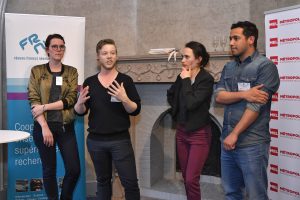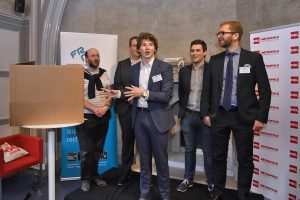RFN-MEL Hackathon 2017: Projects Review

The 12th of May 2017, the final day of the three day Hackathon organized at the LILLIAD Learning Center, by the Réseau Franco-Néerlandais (RFN) and the Métropole Européenne de Lille (MEL), five groups of highly competitive hackathonians presented their projects in front of a jury of experts in different domains, i.e. tourism, history, urbanism and culture in the low countries. Here below you can discover the results of their hard work.
Borderation
By Fleur Copier (Avans University for Applied Science, Den Bosch), Neira Hublic (Zuyd University for Applied Science, Maastricht), Charéll de Koster (Zuyd University for Applied Science, Maastricht), Agnie Papaloukas (Avans University for Applied Science, Den Bosch), Jur van Rijn (Avans University for Applied Science, Den Bosch) and Carmen Schellekens (Avans University for Applied Science, Den Bosch)
Copier (Avans University for Applied Science, Den Bosch), Neira Hublic (Zuyd University for Applied Science, Maastricht), Charéll de Koster (Zuyd University for Applied Science, Maastricht), Agnie Papaloukas (Avans University for Applied Science, Den Bosch), Jur van Rijn (Avans University for Applied Science, Den Bosch) and Carmen Schellekens (Avans University for Applied Science, Den Bosch)
The BORDERATION is a collaboration between border cities. For this pilot project the chosen cities are the municipality of Lille, ‘s-Hertogenbosch and Maastricht.
How does it work?
It is an organization that works via a website. The idea is that the website helps students to choose their exchange destination. On the website they can find all the necessary information: the living costs, a forum to chat with students who are already living where they wish going, as well as vlogs with tips.
Who participates?
Students who wish becoming vloggers through the whole year of their exchange should be selected by a competition in the first month of their mobility. They have to give the best tips and info in an interactive way that could keep the attention of the public. After their first vlogs, the best ones will win prices (such as gift cards).
You can find the full presentation here:
Xborder Suitcase
by Julie Alayrac (Université de Lille D&S), Maurice Nuiten (St. Joost Academy of Art and Design, Den Bosch), Ma rion de Ruyter (UVHC Valenciennes), and Amine el Mahdi Safhi (IMT Lille Douai).
rion de Ruyter (UVHC Valenciennes), and Amine el Mahdi Safhi (IMT Lille Douai).
Xborder SUITCASE is a project that represents a symbolical suitcase exchange between the Métropole de Lille and a few cities the Southern Netherlands. The idea is to cross the linguistic border, to meet and represent another culture and use differences as a creative material.
Who is involved ?
On the first hand, young artists selected for their strong social intentions, on the other hand, the inhabitants from both regions, cultural institutions, private structures and the research communities.
What is the aim of the project ?
The aim is to to give access to culture, to all the inhabitants regardless their background or social status.
It also helps artist who not necessarily have the budget to create art, to go abroad and involve with the local population.
What is the concept ?
⁃ A one month cross–border exchange between two artists (one from France, one from the Netherlands)
⁃ Participation in workshops with the inhabitants
⁃ Each artist puts an item of his journey in the symbolical suitcase and passes it to his successor
⁃ The artists get to be published by the local medias and maybe could get offers to organize an exhibition
You can find the full presentation here:
LowCo
 Pense/Denk ‘Beep-Beep’
Pense/Denk ‘Beep-Beep’
Advancing inclusive transportation across borders in the Low Countries
by Cedric Deverchere (Institut d’Urbanisme de Douai), Larissa Schulte-Nordholt (Leiden University/ Cambridge University) and Floris-Jan Willemsen (University of Applied Science Rotterdam).
What do we want ?
We want to make traveling across borders easier between Northern France, Belgium and the Netherlands.
How are we going to achieve this ?
By creating an app that includes all transportation companies in the region, we will simplify travel for everyone. Whether you are a business-owner, a student, or just living in a border region, LowCo (Travel The Low Countries) will make your life easier.
The app will allow you effortlessly to buy tickets for trains, trams, buses and even public bikes by linking up with public transport companies across the region.
Thanks to LowCo and the abolishment of roaming charges in Europe, starting June 15th, you will have Lille and Rotterdam in your pocket – as well as smaller towns, like Hazebrouck and Goirle. Our system will show transport authorities the future, allowing them to follow by converging tariffs and creating the infrastructure.
Today for the Low Countries, tomorrow for all of Europe. You just have to think beep-beep!
You can find the full presentation here:
The Language Experience
 by Milou Cox (Université de de Lille S&T), Bastiaan Langeveld (Université de Lille S&T), Yayha Moumen (Rotterdam University of Applied Science, Rotterdam Business School).
by Milou Cox (Université de de Lille S&T), Bastiaan Langeveld (Université de Lille S&T), Yayha Moumen (Rotterdam University of Applied Science, Rotterdam Business School).
What is the idea ?
The idea of The Language Experience is to solve the problem that Dutch and French students have of not seeing the importance of learning and using Dutch and French language by preferring using English instead.
The context ?
We all have had that moment that you realize you should have paid more attention during your language classes in high school. Languages in high school are often seen as a pure obligation and therefore not fun or useful in the future.
Nevertheless, understanding and mastering a third language is getting more and more important in the globalizing World.
That’s why we offer a template for schools and universities to organize language promotion days. Through these days we want to enthuse students to apply for the buddy system( exchange with another student).
In this way the students can communicate with each other, share experiences, and improve each others language skills.
Does it seem familiar?
You can think of our project as a new and improved ‘pen pal’, because the future European citizen should speak more than 2 languages in other to involve in a changing Europe.
You can find the full presentation here:
La Kijkdoos
by Jesse Van Groenigen (Rotterdam University of Applied Science), Thomas Heckly (Université de Lille 1), Edouard Laroche-Joubert (Université de Lille 3), Björn Kok (HZ University of Applied Science), Wouter Kok (Kausa Communiction and Design).
What is a Kijkdoos?
A Kijkdoos is a traditional Dutch object that every kid makes in its young age. It it a shoe box that contains images and dolls. The kids could look into each others boxes and discover the secret universe of their childhood imagination.
The idea of this project ?
The aim of this project is to awake the curiosity of people. For this purpose the Kijkdoos represents a big white shoe box with no outside marks but with a door through which people can enter the mysterious box.
The idea is to have one box in the city of Rotterdam that represents Lille, its area and its inhabitants to the Dutch people and the other way around: to represent Rotterdam, its spirit and culture to Lille’s inhabitants.
This project could involve other cities later on and become an annual tradition of cooperation and sharing.

